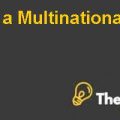
New York Times
Questions:
1.) Analyse the ownership construction that allows the family to control the New York Times (NYT). Beyond the desire to control NYT, which potential problems have led the family chief(s) to implement this ownership structure?
The ownership construction of New York Times was based on dual-class share structure. The company had classified the shares as Class A shares and Class B shares. According to the ownership construction of the company when it went public to sell the Class A shares in public at AMEX, it had to share some percentage of the voting rights. Initially, the Class A shareholders could elect three of company’s nine board of directors but later on, the voting rights were made constant at 30% regardless of the size of the board.
This particular type of ownership structure of dual-class share structure was implemented in NYT for several purposes. First purpose was the environmental effect as 70% of the daily newspapers were family-owned businesses. The data of 2006 shows that only three out of twelve family controlled largest publicly traded U.S. newspaper companies did not have this dual-class share structure.
The main reason behind this ownership structure of the companies was to preserve the family control as a Public Corporation. The family businesses that were to go public to gain better access to capital had an issue that they did not want to share their authority in the company. The initial step that these companies took to protect their rights was to issue a small part of shares in the public and retain the majority shares with the family but they could not stop the later generation from selling their shares as they did not have that kind of attachment with the company and thus the company would be up for sale according to the formers of the company as their heirs would no longer be associated with the company.
Due to this problem, the family chief implemented this ownership structure in the NYT according to which no Class B share that had the higher board control could be sold in the public without converting them into Class A shares. They issued two different classes of stocks that had different controlling rights. By restricting the selling of one particular class of share, that had more voting power and the right to elect majority of the board of director; the company ensured its family control over the years to come with younger generation. In this way, the 70% rights of the family will not fall into the hands of general public even if the later generations sold out their shares.
Beyond the desire to control NYT, Sulzberger felt a special responsibility to maintain the editorial independence and integrity of the Times. They argued that the only way to maintain this journalistic integrity which was demanded by the newspapers; urged the need to have higher family control of the business. At the time of renewal and extension of trust, they stated that this step is taken ‘to maintain the editorial independence and integrity of The New York Times and to continue it as an independent newspaper, entirely fearless, free of ulterior influence and unselfishly devoted to the public welfare’.
Another major reason for implanting this particular ownership structure was to avoid the hostile takeovers with regards to any situation in future. In normal circumstances when the majority of shares are bought by a single entity, then that entity is entitled as the majority holder with higher rights in the decision of the company and sometimes the majority of shares is so high that the views of the original founder of the company are no longer considered in the decision-making process of the company.
The Class B shares protect the company from any such situation which can be created by the investors. This type of arrangement was not allowed at NYSE initially but with most companies following this structure; NYSE had to change its rule of one share possessing the right of one vote. Thus, a specific category had more voting power in one share whereas the other category had a relatively lesser power in one share.
This was evident by one incident in 1980 when Saul Steinberg announced that he would buy a greater number of shares of NYT. He was a financer, known for buying large stakes in newspaper companies. He had just 5% shares in NYT when he announced that he is going to increase the share percentage to 30%. There was a buzz in the market and every step taken by him indicated that he had a vision of executing a hostile takeover, but the company’s rights were safely protected because of the board-controlling Class B shares. Steinberg could not take control of the company and got convinced to drop his ideas; he gave up his plans and sold out his 5% stake back to the company at the prevailing market price.
This clearly indicated the motivation of the company to issue different classes of shares in the market to protect itself from losing control over the company.
2.) Evaluate the arguments behind MSIM's claim and the dilemma it raises for the family behind New York Times.
MSIM claimed that the dual-class share structure did not favour the public shareholders and that these share structures should be completely eliminated; so that the shareholders can also have a higher control over the company’s decisions.
MSIM raised the claim and dilemma for the family that the special privileges do not come for free. In addition, if the family members wanted to enjoy these privileges, then they must.................
This is just a sample partial case solution. Please place the order on the website to order your own originally done case solution.













